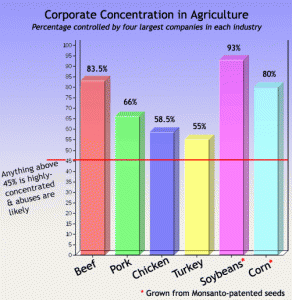January 2010
Dear Farm Aid,
I keep hearing about “concentration” in farming. What does that mean and how does it affect me?
Thanks!
Matthew K.
Minneapolis, MN
Well, Matthew, you’ve asked me one doozy of a question for my first column! But I can’t say I’m not grateful for it—your question hits at the heart of several problems in today’s food and farm system as well as new opportunities that have appeared this year to shake things up for the better.
What does concentration mean?
The short of it is this: growing concentration in the farming industry is pushing you and the more than 300 million eaters in the United States farther and farther away from the family farmers who grow our food.[1, 2]
People use the word concentration to describe the control that a small number of corporations have over the whole of food production and consumption in our country. Our farming sector suffers from abnormally high levels of concentration and the consequences have been rather nasty. The trend has forced thousands of independent family farmers off the land and has caused serious damage to rural economies, public health and our environment.[3<]
To illustrate just how out of whack it’s gotten, consider what economists call the “four-firm concentration ratio.” Most economic sectors have concentration ratios hovering around 40%, meaning that the top four firms in the industry control 40% of the market. Anything beyond this level is considered “highly concentrated,” where experts believe competition is severely threatened and market abuses are likely to occur.
Two researchers at the University of Missouri, Mary Hendrickson (this month’s featured Farmer Hero) and Bill Heffernan, have studied these ratios in agricultural markets. The situation doesn’t look good. As of 2007, four companies owned 83.5% of the beef market—that’s more than 40 percentage points above the “highly concentrated” cut-off! Similarly, four firms owned 66% of the hog industry and 58.5% of the broiler industry. At the same time, 93% of soybeans and 80% of corn grown in the United States were under the control of just one company, Monsanto, through their patents.[4]
Are your eyebrows raised yet? These are astronomically high numbers! As one researcher put it, “[n]ever before have the safety and sustainability of our food supply depended on the decisions of so few companies.”[5] I couldn’t say it any better. It’s nearly certain that something’s a little fishy in our curiously concentrated farm sector.
What it means for farmers…
It’s helpful to consider the structure of our food system, where farmers supply the raw goods for the many products that are collected, processed, packaged, and distributed by numerous other businesses before they reach us. Each of these stages represents a different link in the supply chain that moves food from farm field to kitchen table.
As a key link in this chain, farmers rely on both buyers and sellers, and concentrated markets squeeze them at both ends. Sellers with high market power can inflate the prices of machinery, seeds, fertilizers and other goods that farmers need for their farms, while powerful buyers suppress the prices farmers are paid for what they grow and raise.[6, 7]
The resulting razor-thin profit margins that farmers and ranchers are forced to endure often push them to either expand into mega-operations or exit the business altogether. Even tiny movements away from a fair and competitive market price have choked farmers’ bottom lines, siphoning money into the hands of the corporations that dominate the market and away from the rural economies that house and support our nation’s farms and ranches.[8]
What it means for eaters…
Family farmers are clearly getting the short end of the stick, but the current system isn’t doing a heck of a lot for us eaters either.
Despite the promise of cheaper food that is supposed to result from increased concentration, USDA data shows that the cost of food to consumers has risen steadily since the 1980s.[9] The system also narrows consumer choice and presents barriers to accessing locally-grown, organic, sustainable, and family farm-identified food. For example, if you or I want more local food in our supermarket aisles, we’ll run up against giant supermarket chains with a single, national buyer that supplies thousands of stores. This structure is generally inaccessible to small and mid-sized independent family farmers who lack power to get a fair price for their goods.[10]
So who benefits? Well, if I do my math right, this leaves the corporations that act as middlemen and, let’s see, only the corporations that act as middlemen.
So what can we do about it?
Actually, we already have most of the tools we need. Concentration generally happens through two avenues: via consolidation from mergers and alliances or through vertical integration, where one company controls most or all of the businesses along the supply chain.
A few laws—namely the Sherman Antitrust and Clayton Acts—exist to prevent excess power in the marketplace. However, particularly in the agricultural sector, enforcement of these laws has been virtually nonexistent, especially in the last 10 years.[11] What’s more, they generally don’t address vertical integration and are blind to the peculiar nature of some agricultural markets, where one firm can dominate in a rural area or region, even if it doesn’t control a large share of the market nationally.[12]
Another law, the Packers and Stockyards Act (PSA), was created to regulate packers, livestock and poultry dealers, swine contractors and other middlemen in our livestock industry. The PSA does have the power to address vertical integration in agricultural markets. However, there has been a long history of mismanagement and poor enforcement that is only starting to be addressed by our current administration.
But that’s where we come in.
You may have heard that the United States Department of Agriculture and the Department of Justice are scheduling public workshops throughout 2010 to address the issue of concentration, antitrust violations and competition in agriculture. This presents an unprecedented opportunity for positive change, and a massive challenge.
Have no doubt that a fight is brewing between those of us interested in growing the Good Food Movement and those that are interested in maintaining their power and safeguarding the status quo. Farm Aid intends to be heavily engaged in these workshops and will keep all of our readers informed of key developments and opportunities to take action. The workshops will only create the change we need if farmers AND consumers get involved. Stay tuned.
In the meantime, I can’t stress enough how important it is to make your voice heard. This may be the best shot we’ll see in a while to make transformative change in our food system. If we do it right, we could make major strides in rebuilding a food system that works for farmers, eaters and everyone in between—offering stable and fair prices to farmers and delivering fresh, healthy and safe food for us all.
So Matthew, I hope you have some fight in you. This issue is a matter of survival to our country’s family farmers and control over the food that nourishes our bodies. I encourage you all to send more questions and comments our way on this complicated, but extremely important subject.
Many thanks to you and, as always, eat well,
Alicia
Sources:
1.Starmer, E. (2007). Corporate Power in Livestock Production: How it’s Hurting Farmers, Consumers, and Communities-And What We Can Do About It. Leveling the Field-Issue Brief #1, Agribusiness Accountability Initiative.
2.Food and Water Watch (December 31, 2009). Public Comment to USDA and Department of Justice Re: Agriculture and Antitrust Enforcement Issues in our 21st Century Economy. Washington, D.C., USDA and Department of Justice.
3.Food and Water Watch (December 31, 2009).
4.Hendrickson, M., Heffernan, William D. (2007). Concentration of Agricultural Markets. Columbia, MO, Department of Rural Sociology, University of Missouri. April 2007., and Food and Water Watch (December 31, 2009).
6.Wilson, M. (2009). Curbing Concentration: an uphill climb. OCM News. Lincoln, NE, Organization for Competitive Markets. December 2009.
9.Ibid. Data is adjusted for inflation.
10.Food and Water Watch (December 31, 2009).
11.Varney, C. A. (2009). Merger Guidance Workshops. Third Annual Georgetown Law Global Antitrust Enforcement Symposium, Washington, D.C., U.S. Department of Justice.


